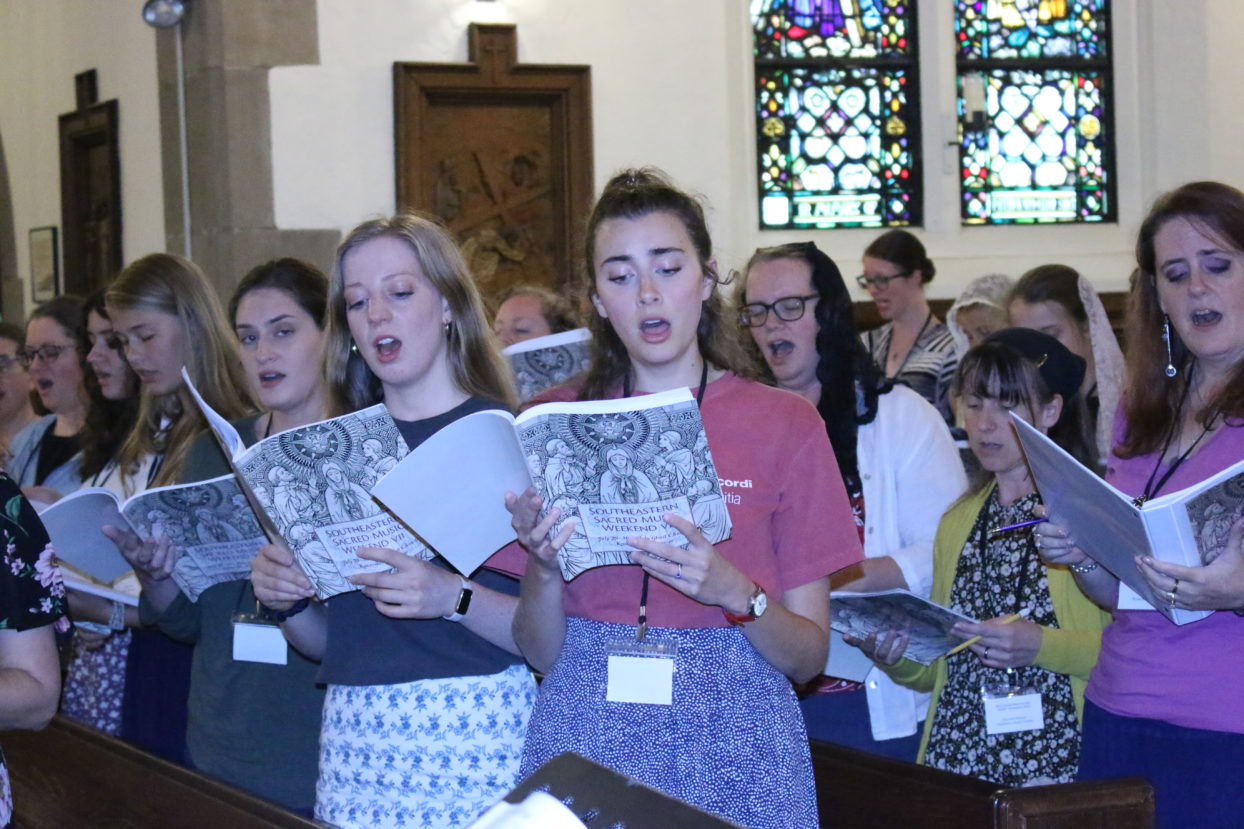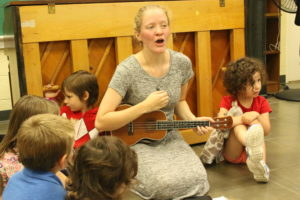A two-day weekend gathering and a Chant Camp for children draw dozens of participants
By Dan McWilliams
Lovers of sacred music, especially Gregorian chant, of all ages attended two special events at Holy Ghost Church in recent weeks.
The North Knoxville parish hosted the seventh Southeastern Sacred Music Weekend on July 29 and 30 and a Chant Camp for youth May 23-25. The Sacred Music Weekend drew about 70 participants and eight presenters, with attendees coming from Tennessee, Georgia, Alabama, Mississippi, and from as far away as Indiana, New York state, and Minnesota. The Chant Camp attendance was about 30.
The Sacred Music Weekend has been held in Georgia, North Carolina, and Tennessee over the years, including at the Basilica of Sts. Peter and Paul in Chattanooga in 2016. The event is co-sponsored each year by the hosting parish and Southeastern Sacred Music, a chapter of the Church Music Association of America.
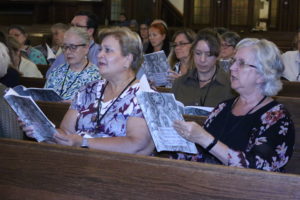
The intermediate choir at the Southeastern Sacred Music Weekend was directed by Mary Jane Ballou, the director of Cantorae, a women’s a cappella ensemble in St. Augustine, Fla. Bridget Scott, director of liturgical music at St. Monica Parish in Duluth, Ga., worked with the novice singers.
“The workshop was designed to accommodate anyone interested in Gregorian chant and the sacred music tradition of the Catholic Church,” said Mary C. Weaver, director of music ministry at Holy Ghost. “Most attendees were singers; many were choir directors; and several were organists. One priest [Father David Carter, rector of the basilica] and two seminarians were participants. Some attendees don’t think of themselves as singers but were simply interested in learning more. There are typically three tracks to this event: one for absolute beginners who don’t yet know anything about Gregorian chant, one for intermediates, and one for advanced singers.”
Each of the three groups rehearsed with a specific director each day.
“During the rehearsals, participants learn more about chant and also prepare the music to be sung for the culminating Mass on Saturday evening,” Mrs. Weaver said. “There are also ‘tutti’ rehearsals in which everyone participates and focuses on learning the Mass ordinary (Kyrie, Gloria, Credo, Sanctus, and Agnus Dei) that will be sung on Saturday. On Friday evening the entire group also chanted Vespers for the Memorial of St. Martha.”
In addition, participants were able to choose from various “breakout sessions”—hourlong workshops on topics of interest to clergy, organists, music directors, and singers. Breakout session topics included “What Did Vatican II Really Teach About Sacred Music?”, “Free and Low-Cost Sacred Music Resources,” “From Blah to Brilliant: Strategies for Getting the Most Out of the Volunteer Choir,” and “Planning Worthy Music for Mass: Best Practices and Resources.”
A number of skills were taught or refined in the workshop, depending on the level of experience of the participants.

About 30 youth improved their chant reading and singing skills during Holy Ghost’s summer Chant Camp. Music director Mary Weaver (above) talks about the importance of singing chant smoothly, by connecting each note to the one before.
“Those who had no experience with Gregorian chant were able to learn how to read/sing the square notes and the four-line musical staff used in chant,” Mrs. Weaver said. “The chants sung at Mass ranged from extremely simple English chants for the beginners to the complex and ancient chants found in the Graduale Romanum (or Roman Gradual, the official choir book of the Catholic Church). All the choral conductors were capable, experienced teachers who also worked with attendees to improve the beauty and fluidity of their chant singing.
“The conductors of the intermediate and advanced groups also helped their singers prepare polyphonic (multi-voice) music for Saturday’s Mass, including an English motet by Orlando Gibbons (1583-1625) and Latin motets by Orlando di Lasso (1532-1594) and by contemporary composer Mariano Garau.”
Mrs. Weaver explained what sacred music is.
“Many people think that the term ‘sacred music’ means any sort of music whose text talks about God or about religious experience. That’s not accurate,” she said. “Music can be religious—that is, it can talk about religious faith or experience—without being worthy of God’s temple, that is, without being sacred, or set apart for worship. I could set the 23rd psalm to a melody composed by the Beach Boys, and the text, although sacred, would not make the music sacred. If you can’t hear the words of a song and it sounds like pop music, it is in fact pop music. The musical style alone can disqualify a song from use in church.”
An analogy further elaborates on the point, Mrs. Weaver added.
“When I walk into Walmart, there’s no mistaking that it is a place of business and 100 percent secular. Everything I see, hear, smell, and experience tells me this,” she said. “If I walk into an ancient European cathedral, everything I see, hear, smell, and experience tells me I am in a sacred space. The ceiling is lofty, which instinctively makes me feel the grandeur of God and my own smallness. The stained-glass windows, lovely statues and paintings, intricately tiled floors, and grand altar all communicate a message of otherworldliness. This space is quite literally set apart—sacred. It is utterly unlike our homes, businesses, and government buildings. It is impossible not to experience the cathedral as sacred and the Walmart as secular.
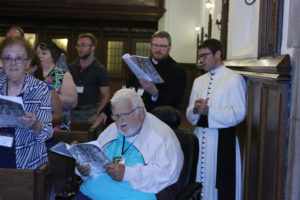
Father David Carter (holding music), rector of the Basilica of Sts. Peter and Paul, and Father Michael Hendershott, associate pastor of Holy Ghost, sing at the Sacred Music Weekend.
“It’s just the same with sacred music. It should be immediately and unmistakably different from the music we enjoy at a pop concert, an opera, a campfire, or a civic parade.”
Chant is often heard in movies, Mrs. Weaver said.
“When you watch a movie or TV show that’s trying to depict the Catholic Church, you will very often hear Gregorian chant or the polyphonic sacred music of the Renaissance because both of those styles were created by the Church for the Church. Even to the casual listener, they communicate ‘this is Catholic,’” she said.
The best definition of sacred music, Mrs. Weaver said, “can be found in a document called Tra le sollecitudini issued by Pope St. Pius X in 1903 specifically to combat the theatrical and operatic music that had made its way into the Church of his day. In that motu proprio, Pius X said that sacred music should ‘possess, in the highest degree, the qualities proper to the liturgy, and in particular sanctity and goodness of form.’
“He went on to say that ‘it must be holy and must, therefore, exclude all profanity.’ By profanity, he means worldliness—that which is of the secular world. Finally, it must be ‘true art’ and its forms must possess ‘universality,’ such that ‘nobody of any nation may receive an impression other than good on hearing them.’”
On those grounds, “Gregorian Chant has always been regarded as the supreme model for sacred music, so that it is fully legitimate to lay down the following rule: the more closely a composition for church approaches in its movement, inspiration, and savor the Gregorian form, the more sacred and liturgical it becomes; and the more out of harmony it is with that supreme model, the less worthy it is of the temple,” the Holy Father continued.
The importance of Gregorian chant and sacred polyphony are also strongly emphasized by the Vatican II document Sacrosanctum concilium and by the General Instruction of the Roman Missal, the third edition of which was published in 2011. “So the Church of the past and of today has very definite views on sacred music and provides a great deal of guidance for music ministers,” Mrs. Weaver said.
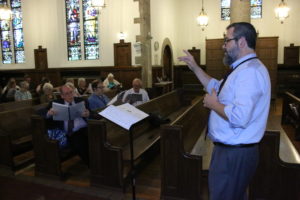
Alex Hill, who directed the advanced men’s schola during the Sacred Music Weekend, conducts participants before Mass begins July 30. Mr. Hill is director of the Carolina Liturgical Chorale and lives in Cary, N.C.
Tra le sollecitudini further states that “sacred music, being a complementary part of the solemn liturgy, participates in the general scope of the liturgy, which is the glory of God and the sanctification and edification of the faithful. It contributes to the decorum and the splendor of the ecclesiastical ceremonies, and since its principal office is to clothe with suitable melody the liturgical text proposed for the understanding of the faithful, its proper aim is to add greater efficacy to the text, in order that through it the faithful may be the more easily moved to devotion and better disposed for the reception of the fruits of grace belonging to the celebration of the most holy mysteries.”
Regarding “the qualities proper to the liturgy,” Pope St. Pius X wrote that they “are to be found, in the highest degree, in Gregorian chant, which is, consequently the Chant proper to the Roman Church, the only chant she has inherited from the ancient fathers, which she has jealously guarded for centuries in her liturgical codices, which she directly proposes to the faithful as her own, which she prescribes exclusively for some parts of the liturgy, and which the most recent studies have so happily restored to their integrity and purity. . . . The ancient traditional Gregorian Chant must, therefore, in a large measure be restored to the functions of public worship, and the fact must be accepted by all that an ecclesiastical function loses none of its solemnity when accompanied by this music alone.”
At the Sacred Music Weekend, Father Robert Pasley, KCHS, was the event’s keynote speaker and also the celebrant for the Saturday Mass. Father Pasley is the rector of Mater Ecclesiae Parish in Berlin, N.J., and chaplain of the Church Music Association of America.
Chant Camps were held at Holy Ghost in 2021 as well as this year for any children and teenagers of the parish whose parents wanted them to learn more about the music of the Church. Participants included toddlers to teenagers.
“This year we separated the youngsters into those who can read and those who can’t. I worked with the readers (children ages 6 or 7 and up), and we reviewed the basics of reading and singing Gregorian chant. I think my group was 18 to 20 people,” Mrs. Weaver said.
She added that “it’s not at all usual for children to learn chant. After Pius X’s document Tra le sollecitudini came out in 1903, it sparked an entire movement to teach chant to children. The main proponent was a woman named Justine Ward, whose ‘Ward method’ of teaching chant took hold in Catholic schools throughout the United States, Europe, and other parts of the world. From about the 1920s through the 1960s, just about every student in Catholic schools learned how to chant. It’s only post-Vatican II that chant instruction fell out of our schools’ curricula.
“Chant and chant instruction have been undergoing a renaissance in the past 20 years or so, and although I wouldn’t say interest is widespread yet, many Catholic homeschoolers are taking it up.”
Mrs. Weaver said she thought the Chant Camp went well.
“Children love to sing, and they learn quickly,” she said.
Clara Cowan assisted Mrs. Weaver with the Chant Camp, even playing a ukulele as part of her instruction to the younger group of kids.
“Clara Cowan worked with the young children. She’s great at teaching music to kids and is a recent graduate of the UT music school. She and her husband, Blayne, are Holy Ghost parishioners,” Mrs. Weaver said.
Father Carter, rector of the basilica, reflected on the Sacred Music Weekend.
“The Second Vatican Council said that the sacred music of the Church is ‘a treasure of inestimable value,’ and it’s worth preserving,” he said. “And so the Southeastern Sacred Music chapter of the Church Music Association works to promote this treasure of inestimable value in the Southeast. We have hosted it at the basilica.
“We owe a duty of praise to God, and the sacrifice of our voices raised to Him is our duty because of what He has done for us, to give thanks with full voice. There’s a famous father of the Church who said that ‘he who sings, prays twice,’ so we want to really pray.”
Sacred music “is different because it’s specifically liturgical music,” Father Carter said. “It’s music meant to accompany the Holy Sacrifice of the Mass and the sacred actions of the Church when she prays. This is not merely religious music. It’s very distinct from religious music. Hymns are religious music; they’re not liturgical music. Gregorian chant, the propers of the Mass, the ordinary of the Mass—those are actual texts written in the liturgical books to be sung. We are trying to help recover this beautiful heritage and tradition that’s been handed down to us. It’s found in every single Roman Missal in every single parish around the world, and yet most people are unfamiliar with it or have never been introduced to it. This workshop is meant to open the doors to the wonderful and deep richness of the sacred music tradition of the Church.”
Sarah Harson of St. Mary Magdalene Church in Simpsonville, S.C., attended the weekend for the second time.
“I’m a director of music. I found this group last year and found that they were much more true to what we are called to do as music ministers and as pastoral musicians in the Catholic Church, much more in line with that than most other associations,” she said. “I have just been excited to be around like-minded people who are pushing liturgy to be what it’s meant to be and not what it’s become out of cultural appropriation and whatever else.”
Holy Ghost Church, with its 1920s architecture and stained-glass windows, “is beautiful,” Ms. Harson said.
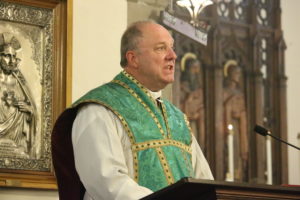
Father Robert Pasley, KCHS, was the keynote speaker at the Sacred Music Weekend and celebrated Mass on the second and final day of the event July 30.
“They have a lot better acoustics than we do. It looks more like a church. We kind of have that ’70s living room Catholic church. [Holy Ghost] has got a nice acoustic, not too much reverb—it’s just enough.”
Ms. Harson learned several things at the Sacred Music Weekend.
“I think a lot of the things for me here are just remembering that I am in a good place,” she said. “I hear some of the stories of some of the troubles people have at their parishes, their small numbers, and we’re really blessed to have a flourishing parish still and two young vicars who are very encouraging in pushing the liturgy toward where it needs to go. Even though we’re nowhere near where we need to be, I think I take away from this mostly just to be grateful for the progress we’ve made and to continue making it—that encouragement comes from this.”
Paulette Croteau, a cantor at St. Mary Parish in Athens, was among those from the Diocese of Knoxville attending the weekend.
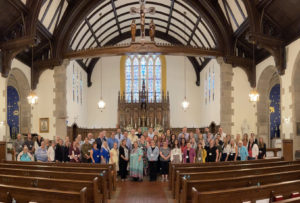
The more than 70 participants and instructors at the Sacred Music Weekend at Holy Ghost Church gather for a picture on July 30.
“I sang Gregorian chant as a young girl in high school and thought I could do this, and I found out it’s all new,” she said. “I never learned the rubrics of what I was doing, so this has been exciting and uplifting for me. I’ve learned that the Gregorian chant was never really canceled out, and I’m excited about that because I want to bring that back to my parish.”
She is also a fan of Holy Ghost Church.
“I love it. I love the spirit,” she said. “I love the ability to come here and worship with reverence. It reminds me of the church that I was baptized in in Massachusetts, with the side altars and everything so holy. It just draws your attention to God.
“That helps with the music: It helps, because it’s part of the beauty and the cohesiveness of what we’re doing. Worshiping God—that’s our primary job here.”

